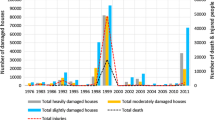Abstract
In Iran, earthquakes cause enormous damage to the people and economy. If there is a proper estimation of human losses in an earthquake disaster, it could be appropriately responded and its impacts and losses will be decreased. Neural networks can be trained to solve problems involving imprecise and highly complex nonlinear data. Based on the different earthquake scenarios and diverse kind of constructions, it is difficult to estimate the number of injured people. With respect to neural network’s capabilities, this paper describes a back propagation neural network method for modeling and estimating the severity and distribution of human loss as a function of building damage in the earthquake disaster. Bam earthquake data in 2003 were used to train this neural network. The final results demonstrate that this neural network model can reveal much more accurate estimation of fatalities and injuries for different earthquakes in Iran and it can provide the necessary information required to develop realistic mitigation policies, especially in rescue operation.







Similar content being viewed by others
References
Ahadzadeh S, Valadanzouj M, Sadegian S (2008) Detection of damaged building after an earthquake using artificial neural network algorithm. In: ISPRS 21st. Silk road for information from imagery, Beijing
Bandyopadhyay G, Chattopadhyay S (2007) Single hidden layer artificial neural network models versus multiple linear regression model in forecasting the time series of total ozone. Int J Environ Sci Tech 4(1):141–149
Chen Q, Chan YW (2003) Structural fault diagnosis and isolation using neural network based on response only data. Comput Struct 81(22–23):2165–2172
Coburn A, Spence R (2003) Earthquake protection, 2nd edn. Wiley, Chichester
Federal Emergency Management Agency (FEMA) (2003) Hazus-MH MR1 technical manual. FEMA mitigation division, Washington
Ghafory-Ashtiany M, Hosseini M (2006) Post bam recovery and reconstruction. Nat Hazards 44(2):229–241
Goh TC (2002) Probabilistic neural network for evaluating seismic liquefaction potential. Can Geotech J 39:219–232
Hanna MA, Ural D, Saygili G (2007) Neural network model for liquefaction potential in soil deposits using Turkey and Taiwan earthquake data. Soil Dyn Earthq Eng 27(6):521–540
Haykin S (1999) Neural networks: a comprehensive foundation, 2nd edn. Prentice-Hall, Englewood Cliffs
Hornik K, Stinchcombe M, White M (1989) Multilayer feed forward networks are universal approximators. Neural Netw 2(5):359–366
Hung SL, Kao CY (2002) Structural damage detection using the optimal weights of the approximation artificial neural network. Earthq Eng Struc 31(2):217–234
Japan International Cooperation Agency (JICA) (2000). The study on seismic microzoning of the greater Tehran area in the Islamic Republic of Iran. Main report, Tehran
Kuok KK, Harun S, Shamsuddin SM (2009) Particle swarm optimization feedforward neural network for modeling runoff. Int J Environ Sci Tech 7(1):67–78
Lin WT, Lin CY (2008) Earthquake-induced landslide hazard and vegetation recovery assessment using remotely sensed data and a neural network-based classifier: a case study in central Taiwan. Nat Hazards 47(3):331–347
Murakami HO (1992) A simulation model to estimate human loss for occupants of collapsed buildings in an earthquake. In: WCEE 11th. Earthquake engineering. Madrid
Teimori M, Delavar MR, Chavoshi SH (2008). A SDSS-based earthquake damage assessment for emergency response: case study in Bam. In: ISPRS 21st. Silk road for information from imagery. Beijing
Vafaeinezhad AR, Alesheikh AA, Nouri J (2010) Developing a spatio-temporal model of risk management for earthquake life detection rescue team. Int J Environ Sci Tech 7(2):243–250
Vahidnia MH, Alesheikh AA, Alimohammadi A, Hosseinali F (2009) Landslide hazard zonation using quantative methods in GIS. Int J Civil Eng 7(3):176–189
Wang J, Sui J, Guo L, Karney BW, Jüpner R (2010) Forecast of water level and ice jam thickness using the back propagation neural network and support vector machine methods. Int J Environ Sci Tech 7(2):215–224
Wyss M (2005) Human losses expected in Himalayan earthquake. Nat Hazards 34(3):305–314
Author information
Authors and Affiliations
Corresponding author
Rights and permissions
About this article
Cite this article
Aghamohammadi, H., Mesgari, M.S., Mansourian, A. et al. Seismic human loss estimation for an earthquake disaster using neural network. Int. J. Environ. Sci. Technol. 10, 931–939 (2013). https://doi.org/10.1007/s13762-013-0281-5
Received:
Revised:
Accepted:
Published:
Issue Date:
DOI: https://doi.org/10.1007/s13762-013-0281-5




